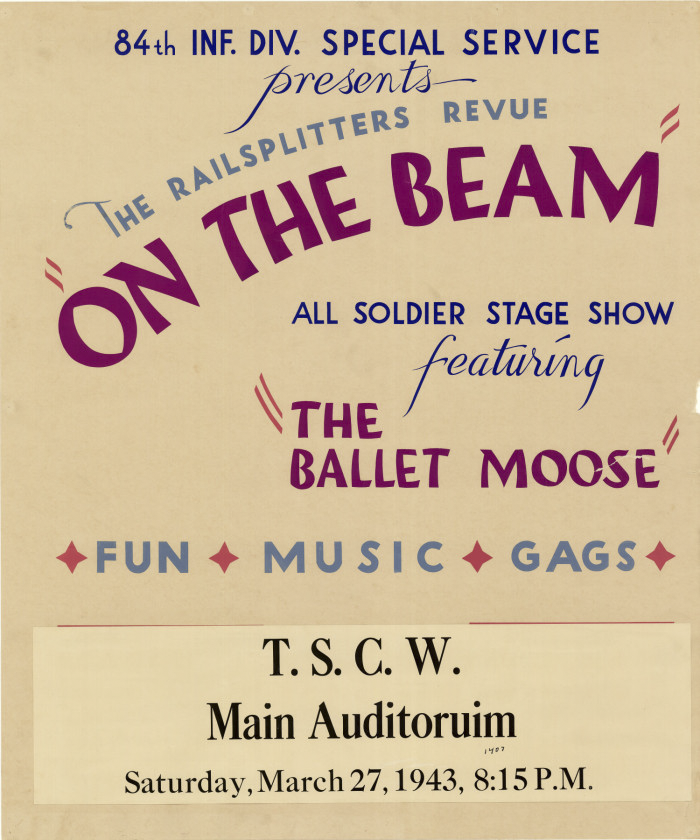
Eighty years ago today, on March 27, 1943, the citizens of Denton, Texas were treated to a musical extravaganza performed at the Main Auditorium of what is today known as Texas Woman’s University, but was then called Texas State College for Women. The all-soldier cast was composed of about 75 members of the 84th Infantry Division (nickname “The Railsplitters”), one of several units stationed at Camp Howze, an infantry replacement training center located just west of Gainesville.
Camp Howze and the 84th Infantry Division
Camp Howze was established by the U.S. War Department on a 59,000-acre tract purchased from local farmers (in some cases an “offer they couldn’t refuse”). The camp served as a training ground for several hundred thousand U.S. soldiers between 1942 and 1946, and toward the end of the war also housed many German POWs. Among the units prepared for action at Camp Howze were the 84th, 86th, and 103d divisions.
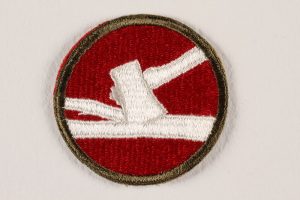
US Army 84th Infantry Division shoulder sleeve patch with an axe splitting a rail.
United States Holocaust Memorial Museum Collection
The 84th Division earned its nickname “The Railsplitters” based on the fact that when it was first formed during World War I, it was primarily composed of National Guard (i.e., National Army) units from Illinois, Kentucky, and Indiana—states historically associated with President Lincoln. It was then nicknamed the “Lincoln” division and its original insignia was a red axe on a white background within a red circle, with the name “Lincoln” above the axe and the number “84” below it. During World War II the insignia was changed to a white axe splitting a white rail on a red circular background. Both insignias recall the image of President Lincoln splitting logs as a youth. After adding the split rail to the axe, the 84th Division adopted the new nickname of “Railsplitters.”
Production of On the Beam
The entire show was under the supervision of 1st Lt. Don McCallister, the Recreation Director for the 84th Division.
Pvt. Paul Sutton served as the production manager of the show, making use of his extensive experience as a writer and actor in radio and as performer in a number of B-movies—primarily westerns, including six Hopalong Cassidy pictures. In 1931 Sutton had been mustered out of the 251st Coast Artillery, California National Guard, after four years’ service as a staff sergeant.
Pvt. Manny Groobin, newspaperman and short story writer, Pvt. Michael Molony, who had worked for a Hollywood publicity agency before the war, and Master of Ceremonies Staff Sgt. Warren Doering were producers of the show.
Like other soldier shows performed during the war, this G.I. issued musical revue served multiple purposes:
- For the soldiers, it provided a boost to company morale and a welcome relief from the tedium, drudgery, and discomforts of camp life.
- For the local community, it provided an opportunity to enjoy a rare array of talent. The 84th infantry division featured an unusually large number of then-popular stars of stage, screen, and radio.
- For the women of TSCW, events before and after the show provided an opportunity to meet the soldiers and potentially form more intimate relationships with them. On the afternoon before the show, members of the all-soldier cast were treated to a buffet supper by the Art Club, and were invited to arrange dates through the TSCW Date Bureau and to attend the TSCW College Club after the performance.
- Perhaps the most important cause was to raise funds for the war effort. Audiences gained admission to the show by purchasing war bonds or stamps in lieu of tickets.
“The Date Bureau in Action,” The Daedalian, 1943.
Curtain Up! Light the Lights!
Journalist Dorothy Trant provided a vivid account of the show’s prologue:
“A splash of khaki, a bit of army jive, a signal for a spot on the M.C. and On the Beam opened to a full house of WAACs, college personnel, TSCW gals and friends Saturday night.”
During the show’s prologue, Staff Sgt. Warren Doering performed a “rousing opening soliloquy” as the evening’s Master of Ceremonies.
The 2-hour show was organized into sixteen musical numbers and comedy sketches. This is how the program appeared in a full-page ad published in the Gainesville Daily Register (March 25, 1943):
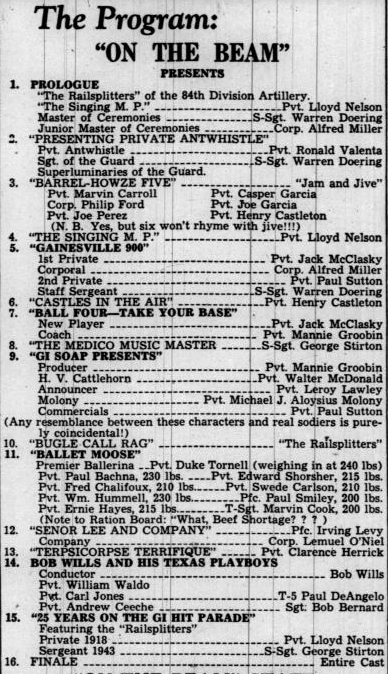
Musical Ensembles
Three ensembles performed during the revue:
The Railsplitters
“The Railsplitters” of the 84th Division Artillery, a big band style ensemble conducted by Tech. Sgt. George Hildebrand, served as the house orchestra and provided the bulk of the musical accompaniment throughout the evening. Although there were 16 members of the band, apparently only 14 played at any one performance.
The Barrel-Howze Five
A six-piece pick-up jazz combo called the Barrel-Howze Five was featured in an act called “Jam and Jive.” (The name was a joke: there were six members of the group, “but six won’t rhyme with jive!!!”) Their opening number was “Put Out Your Can; Here Comes the Garbage Man.” The clarinetist was singled out for special praise.
Bob Wills and His Texas Playboys
James Robert Wills—better known as Bob Wills—was a Texas songwriter, bandleader, fiddler, and guitarist who had brought together frontier fiddle music with jazz and blues to create western swing. In 1940 he and his band (“Bob Wills and His Texas Playboys”) became nationally famous after recording their song “San Antonio Rose.” He had joined the Army in 1942 and put together an all-soldier version of the Texas Playboys to perform in On the Beam.
Musical Numbers
A number of well-known musicians with professional experience were featured in musical acts:
Presented as “The Singing M.P.,” Pvt. Lloyd Nelson wowed the audience with his professional tenor voice, performing the 1921 song “Moonlight and Roses” and the 1910 song “Let Me Call You Sweetheart.” He and Sgt. George Stirton also joined the Railsplitters to perform the medley “25 Years on the GI Hit Parade” as “Private 1918” and “Sergeant 1943,” but what songs they performed were not specified in the program. In 1940, during San Francisco’s Golden Gate International Exposition, Nelson had performed as a member of Fred Waring’s Glee Club at Billy Rose’s Aquacade.

Henry Castleton, a concert violinist who was an member of arranger and conductor John Scott Trotter’s orchestra (which played on recordings for Bing Crosby and others), played “Castles in the Air” according to both the program printed in the Gainesville Daily Register and according to the slightly different program distributed at the TSCW performance, but he is said to have played “Dark Eyes” according an article in the Denton Record Chronicle. Perhaps he played both. He also played in “Jam and Jive” with the Barrel-Howze Five.
The final number on the program, “25 Years on the GI Hit Parade,” features vocalists Pvt. Lloyd Nelson and Sgt. George Stirton with the “Railsplitters” singing hit songs of World War I and of the present war.
Dance Numbers
The “Ballet Moose”
The Ballet Moose was probably the most heavily-promoted act in the show (“a gargantuan thing”) and served as a sort of climax to the proceedings. A slapstick burlesque of the currently popular Ballet Russe, this act featured a “Premier Ballerina” tripping the light fantastic with eight muscular M.P.s, all cavorting in green (blue according to some accounts) tights and pink tutus. Their respective weights were listed in the program and added up to a total of exactly one ton.
According to Publicity Director Pvt. Harry Johnston, “the stars of the ‘Ballet Moose,’ competing for applause with the professionals, will in all likelihood apply more than ordinary energy to their terpsichorean effort.” He suggested as a precaution reinforcing the auditorium stage to withstand the “crushing blows” of a ton of soldier.
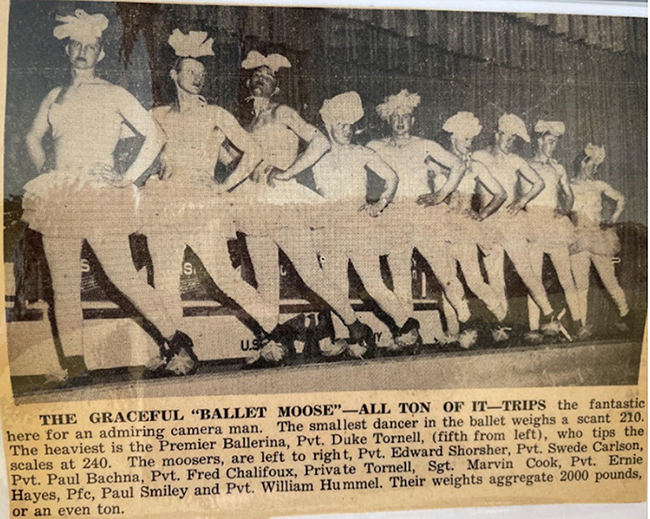
A clipping from the Gainsville Daily Register shows the 84th infantry division.
The 84th presents an all soldier stage show featuring the “Ballet Moose.”
Gainesville Daily Register, Mar 29, 1943. Cooke County Library, TX.
Although the Ballet Moose act was promoted as “strictly a Sutton creation,” the concept was not new—there had already been several college entertainments featuring fraternity brothers or football players dressed in tutus and calling themselves “The Ballet Moose”; for example, at the University of Washington or Bismarck Junior College.
The role of “Premier Ballerina” was taken by Pvt. Deward “Duke” Tornell, who was a multitalented sports star at Ripon High School in the rural community of Ripon, California. Later he attended Modesto Junior College, where according to the Modesto Junior College website he had been “one of the school’s best linemen” and was a star in both football and basketball. Tornell also attended San Jose State College (now San José State University), where he played football, basketball, and baseball. After college he was drafted by the Washington Redskins. A serious back injury he sustained during military training prevented him from participating in the D-Day invasion and also put an end to his professional football career, but he returned to his high school to serve as a volunteer football coach for 25 years.
Deward “Duke” Tornell in his Modesto Junior College football uniform.
Costumes and dances are attributed to Muriel Hensler and the Elm Street U.S.O. Ladies. Muriel Hensler was serving at the time as U.S.O. club director in Gainesville, working with soldiers’ wives and local volunteers to support the troops at Camp Howze. There may have been a costume malfunction (inadvertent or deliberate). Pvt. Sutton made the remark after the show, “I didn’t intend for it to turn into a strip tease. That phase was completely unrehearsed!” Perhaps the troupe took a cue from the men of the University of Washington mentioned above and presented a “Sally Randish balloon dance” as an encore.
“Terpsicorpse Terrifique”
Pvt. Clarence Herrick did what was acknowledged as a “neat bit of tap dancing” in the number entitled “Terpsicorpse Terrifique,” but what could compete with the Ballet Moose? Not to mention, his act was sandwiched in between the hugely popular acts “Señor Lee and Friends” and “Bob Wills and His Texas Playboys.” The tap dancing routine must have served as little more than a palate cleanser.
Comedy Sketches
Several comic sketches broke up the sequence of musical numbers and featured some of the popular actors and sketch writers of the day.
“Shadowlawn, Please” was a satirical skit on the glitchy telephone service in which a private from Camp Howze attempts to notify his WAAC wife by telephone that he cannot come home. Pfc. Jack McClasky, an experienced vaudeville comedian, served as both actor and writer for the vaudeville-style sketch. This skit appears in the program printed in the Gainesville Daily Register as “Gainesville 900.”
Pvt. Manny Groobin’s comedy skit “Ball Four—Take Your Base” was performed as a dialogue, with Pvt. Jack McClasky playing a new baseball player and Groobin playing the coach. Groobin’s acting was praised, but his writing was dismissed as “trite.”
Pvt. Michael J. Aloysius Molony, described as an “Alexander Woolcottish looking man,” wrote the skit “GI Soap Presents,” and also performed the testimonial for GI Soap. Pvt. Sutton played the announcer during the commercials, and Pvt. Walter McDonald played H.V. Cattlehorn. Originality and good timing resulted in plenty of laughs, making this one of the more successful skits.
Pfc. Irving Levy was a bilingual U.S. film, radio, and stage actor who performed in the United States and in Mexico, usually under his stage name of Irving Lee. When he performed in Mexican films, he usually was cast as a non-Mexican because of his thick American accent. When he performed in the U.S., he usually spoke with a Mexican accent. On the George Burns and Gracie Allen radio show he frequently played a character named Señor Lee, who spoke in a mixture of Spanish and heavily-accented English. Here is an example of his Señor Lee character on the Burns and Allen Show: “Kiddie Party” (June 29, 1940). Pfc. Levy’s On the Beam sketch “Señor Lee and Company” was very similar to his Burns and Allen performances, featuring several songs and a rapidly spoken monologue that brought a cascade of laughter with every increasingly absurd punch line.
A Successful Effort
After the performance at TSCW, the show was performed one last time at the junior high school auditorium in Gainesville on March 31, under sponsorship of the local Kiwanis club. Including the first two performances at Camp Howze on the weekend of March 13 and 14, On the Beam received a total of four performances. The sale of war bonds and stamps at the last two performances raised a total of $67,450 for the war effort.
Do You Want to Know More?
Visit Sycamore Library on the University of North Texas Campus to see the physical copy of the poster shown at the top of this article. We also have other posters related to World War I and World War II, as well as scripts, scores, and performance materials related to other soldier shows.
If you need assistance with finding or using government information, please visit the Service Desk in the Sycamore Library during regular hours, contact us by phone (940) 565-4745), or send a request online to govinfo@unt.edu.
If you need extensive, in-depth assistance, we recommend that you E-mail us or call the Sycamore Service Desk at (940) 565-2870 to make an appointment with a member of our staff.
Reference List
“84th Infantry Division.” Order of Battle of the United States Army: World War II, European Theatre of Operations. U.S. Army Center of Military History. https://history.army.mil/documents/eto-ob/84ID-ETO.htm (accessed March 27, 2023).
Hart, Brian. “Camp Howze.” Handbook of Texas Online. Texas State Historical Association. https://www.tshaonline.org/handbook/entries/camp-howze (accessed March 27, 2023).
Camp Howze Museum. This online museum documents the history of Camp Howze in a digital archive containing dozens of historical artifacts.
“Deward ‘Duke’ Tornell.” Modesto Junior College Pirates. [website] https://athletics.mjc.edu/information/hall-of-fame/t/Deward_Tornell?view=bio (accessed March 21, 2023).
“Deward Tornell.” [obituary] The Modesto Bee. (September 7, 2007). https://www.legacy.com/us/obituaries/modestobee/name/deward-tornell-obituary?id=13285773 (accessed March 21, 2023).
“Irving Lee.” Doblaje Wiki, Fandom, Inc. https://doblaje.fandom.com/es/wiki/Irving_Lee (accessed March 23, 2023).
“Muriel Hensler Hokanson Lawrence.” [obituary] Legacy. February 23, 2007. https://www.legacy.com/obituaries/legacy/obituary.aspx?pid=86576649 (accessed March 24, 2023).
“’On the Beam’ Is Successful Here.” Denton Record-Chronicle (Denton, TX). March 29, 1943. University of North Texas Libraries, The Portal to Texas History, https://texashistory.unt.edu; crediting Denton Public Library.
https://texashistory.unt.edu/ark:/67531/metapth1315678/m1/2/ (accessed January 26, 2023).
“Railsplitters Revue in Gainesville!” [full-page advertisement] Gainesville Daily Register and Messenger (Gainesville, TX). March 25, 1943. University of North Texas Libraries, The Portal to Texas History, https://texashistory.unt.edu; crediting Cooke County Library. https://texashistory.unt.edu/ark:/67531/metapth1470351/m1/3/ (accessed January 26, 2023).
“Railsplitters’ Revue Pleases Capacity Crowd.” Gainesville Weekly Register (Gainesville, TX). April 8, 1943. University of North Texas Libraries, The Portal to Texas History, https://texashistory.unt.edu; crediting Cooke County Library. https://texashistory.unt.edu/ark:/67531/metapth1470365/m1/3/?q=%22Ballet%20moose%22 (accessed January 16, 2023).
“’Railsplitters’ Revue to Be Given in City.” Gainesville Daily Register and Messenger (Gainesville, TX). March 22, 1943. University of North Texas Libraries, The Portal to Texas History, https://texashistory.unt.edu; crediting Cooke County Library. https://texashistory.unt.edu/ark:/67531/metapth1470348/m1/4/ (accessed January 16, 2023), University of North Texas Libraries, The Portal to Texas History, https://texashistory.unt.edu; crediting Cooke County Library
“T-7 Sutton, Ex-Movie Man, Plans ‘Railsplitters’ Revue’ at Howze.” Gainesville Daily Register and Messenger (Gainesville, TX), February 17, 1943. University of North Texas Libraries, The Portal to Texas History, https://texashistory.unt.edu; crediting Cooke County Library. https://texashistory.unt.edu/ark:/67531/metapth1470315/m1/5/ (accessed January 16, 2023). University of North Texas Libraries, The Portal to Texas History, https://texashistory.unt.edu; crediting Cooke County Library.
Texas State College for Women. The Daedalian. Denton, TX: 1943. Texas Woman’s University, The Repository@TWU, https://twu-ir.tdl.org/; crediting Texas Woman’s University. https://twu-ir.tdl.org/handle/11274/13520. (accessed on March 23, 2023).
Townsend, Charles R. “Wills, James Robert.” Handbook of Texas Online. Texas State Historical Association. https://www.tshaonline.org/handbook/entries/wills-james-robert (accessed on March 26, 2023).
Trant, Dorothy. “Olive Drab and Jive Mark ‘On Beam’ Show.” Lass-O, Texas State College for Women (Denton, TX). April 2, 1943.
“TSCW Gets ‘On the Beam’ Tomorrow.” Lass-O, Texas State College for Women (Denton, TX). March 26, 1943.
“Uncle Sam’s Paul Sutton to Present ‘On the Beam,’ Army Variety Show.” Lass-O, Texas State College for Women (Denton, TX). March 5, 1943.
U.S. Department of War, Orientation Section, Information and Education Division, ETOUSA. Railsplitters: The Story of the 84th Infantry Division. G.I. Stories of the Ground, Air, and Service Forces in the European Theater of Operations. Paris: Printed by Curial-Archereau, 1945.
“What’s Going on at Camp Howze.” Denton Record-Chronicle (Denton, TX). March 15, 1943. University of North Texas Libraries, The Portal to Texas History, https://texashistory.unt.edu; crediting Denton Public Library.
https://texashistory.unt.edu/ark:/67531/metapth1315666/m1/4/ (accessed January 16, 2023).
“What’s Going on at Camp Howze.” Denton Record-Chronicle (Denton, TX). April 5, 1943. University of North Texas Libraries, The Portal to Texas History, https://texashistory.unt.edu; crediting Denton Public Library. https://texashistory.unt.edu/ark:/67531/metapth1315684/m1/4/ (accessed January 16, 2023).
Article by Bobby Griffith.


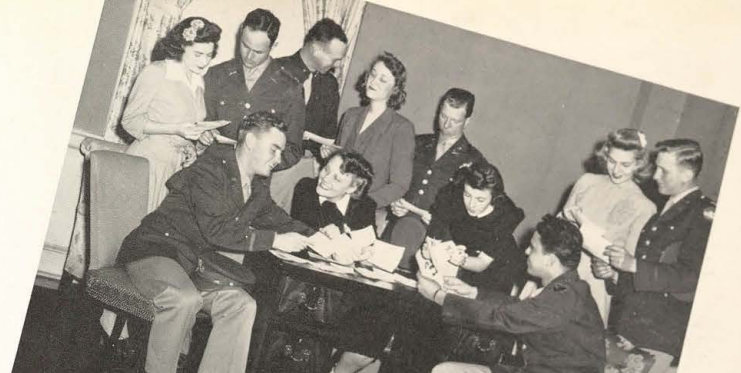

Leave a Reply